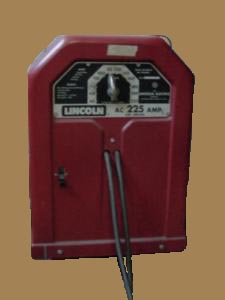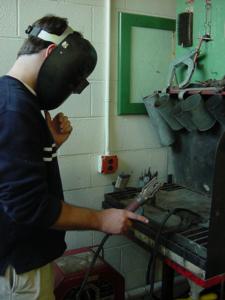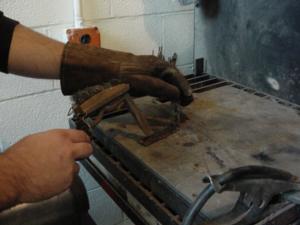Using the Arc Welder
|
|
The arc welder is used for welding or joining two or more pieces of metal together. The metal is heated to a molten state using electricity which creates an arc. Either AC or DC is used and a welding rod appropriate to the metals being used. The two pieces of metal are heated to a molten state and are fused together as the metals blend and a compatible welding rod is melted and used as a fill. |
Controls: The controls on the arc welder in the materials processing laboratory consist of the following:
- Amperage of the welder is adjusted for the electrode being used. Other welders allow adjustments for polarity; AC or DC or DC reverse.
- Welding rod is selected based upon the material to be welded, the position of the weld, and the penetration into the metal that is needed.
Operation: Welding heats metal
and using a filler rod, joins two pieces of metal. Refer to
the following illustrations.
- Clean the metal that is to be welded. It should be free of dirt, impurities and flammable materials.
- Adjust the arc welder to the correct setting for the material and rod being used; AC or DC polarity.
- Connect the ground clamp to the work piece.
- Select the proper welding rod for the metal being welded. Place into rod holder.
- Strike an arc by quickly tapping the welding rod to the work piece or by quickly scratching it across the work piece.
- Maintain the arc length equal to the diameter of the electrode.
- Maintain an angle of 15 degrees off vertical with the welding rod.
- Use a chipping hammer to remove slag from the completed weld.
|
|
|
|
Stock is being fed into the planer. Notice that the worker is wearing welding helmet for eye protection. |
The weld is being cleaned of slag with a slag hammer which forms as the piece is welded. |
Potential hazards: The following hazards exist:
- Materials become hot during welding. Care must be used to avoid touching hot metals.
- Sparks are created avoid contact with flammable materials.
- Eyes may burn when looking at the arc. Use a welding helmet with shade 9 glass.
- A sunburn-type burn is possible on exposed skin; cover arms and neck.
Safety practices: Because of those potential hazards the following safety rules must be followed:
- Eye protection required. The ultra-violet and infra-red rays which are given off during arc welding will burn the eyes. A shade 9 must be used in the shield.
- Eye protection must be worn when chipping flux and when cleaning with the wire brush.
- Electrocution is a possibility with the use of electricity. Avoid standing in puddles or welding while standing on damp ground.
- Do not touch welded metals as they are hot.
- Leather gloves and an apron protect from sparks.
- Wear long sleeves and closed shirt collar to protect arms neck from intense light, spatter and sparks.
- Do not wear particularly flammable clothing such as chamois and nylon.
- Tie back long hair.
References:
Graham, Gregory S. (1981). Metalworking : an Introduction. Boston, Mass. : Breton Publishers. p. 315-333.
Walker, John R. (1972). Exploring Metalworking; Basic Fundamentals. South Holland, Illinois: The Goodheart-Willcox Co. p. 125-131.
Zaner, John. (9/9/01). Circular Saw. [Online]. Available: http://www.usm.maine.edu/~zanerj/252/woodprocess/CircSaw.htm.10 Sept. 2001.
ITT 252 - Materials Processing
Department of Technology
University of Southern Maine
Prepared by Joanne Gauley, 11/15/2001


